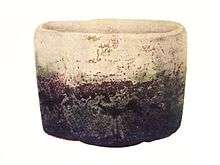Shimamono
blue-white Annan ware with high foot from central Vietnam
Shimamono (島物) is a generic term in the Japanese tea ceremony for utensils produced outside Japan, Korea and China, mainly from southeast Asia.
They were imported with ships on trade routes and started becoming popular in the 15th and 16th centuries. The term therefore literally means "island objects". By the time of the rule of the Shogun Tokugawa Yoshimune, imitation wares were also produced in Japan. However at this point there were called "striped objects", but the pronunciation remained the same.[1] As such they can be counted as part of Japanese pottery and porcelain.
The treatise Tōkikō describes the Japanese pottery trade with Asia and gives detailed descriptions.[2]
- Rusun or Ruson (呂宋焼): items from Luzon, Philippines. The merchant Ruson Sukezaemon (呂宋助左衛門) was particularly connected to the trade in Rusun ware during the rule of Toyotomi Hideyoshi in the 16th century.[3][4][5]
- Annan (安南焼): items from Annam, Vietnam
- Nanban (南蛮焼): items from Southeast Asia
- Amakawa, unidentified location
- Mo-u-ru (モウル), probably from the Moluccas
- To Indu, from eastern India
- Kiao-chih, from Cochin
- Nekoro, probably from the Nikobar Islands
- Taiwan
- Hannera (ハンネラ): a type of simple bisque ware from Southeast Asia
- Kinma (蒟醤): a style of lacquer ware that entered Japan from Siam or Burma
- Sahari (砂張): an alloy of copper, lead, and tin. Some sahari items entered Japan from Southeast Asia
References
- ↑ https://archive.org/stream/chinesepotteryi01laufgoog#page/n40/mode/2up
- ↑ https://archive.org/stream/chinesepotteryi01laufgoog#page/n40/mode/2upe
- ↑ https://books.google.ch/books?id=013dKNOV77oC
- ↑ sambali.blogspot.com/2006/09/luzon-jars-glossary.html
- ↑ http://photos1.blogger.com/blogger/6514/3214/1600/Kyoto%20002.jpg
Literature
This article is issued from Wikipedia - version of the 10/11/2016. The text is available under the Creative Commons Attribution/Share Alike but additional terms may apply for the media files.
